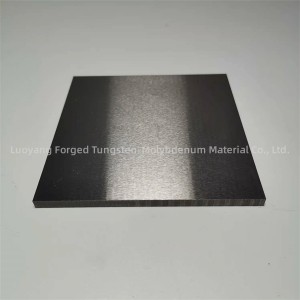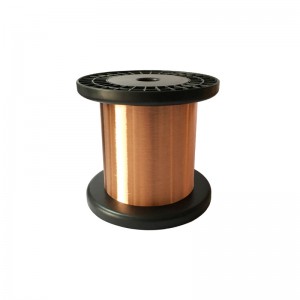Tungsten plate 99.95 purity wolfram plate
Tungsten plate with a purity of 99.95% is a high-quality material and is often called tungsten plate. Tungsten, also known as tungsten, is a dense and hard metal with a high melting point and excellent corrosion resistance. It is commonly used in a variety of industrial applications, including the production of electrical contacts, heating elements and radiation shielding.
| Dimensions | As your requirement |
| Place of Origin | Henan, Luoyang |
| Brand Name | FGD |
| Application | Medical, Industry,Furnace, Electron |
| Shape | As your drawing |
| Surface | Polished, Alkali washing |
| Purity | 99.95% Min |
| Material | Pure W |
| Density | 19.3g/cm3 |
| Packing | Wooden Case |

| Main components |
W>99.95% |
|
Impurity content≤ |
|
|
Pb |
0.0005 |
|
Fe |
0.0020 |
|
S |
0.0050 |
|
P |
0.0005 |
|
C |
0.01 |
|
Cr |
0.0010 |
|
Al |
0.0015 |
|
Cu |
0.0015 |
|
K |
0.0080 |
|
N |
0.003 |
|
Sn |
0.0015 |
|
Si |
0.0020 |
|
Ca |
0.0015 |
|
Na |
0.0020 |
|
O |
0.008 |
|
Ti |
0.0010 |
|
Mg |
0.0010 |
| Melting point | 3410±20℃ |
| Boiling point | 5927℃ |
| Moh's hardness | 7.5 |
| Vickers hardness | 300-350 |
| compressibility | 2.910-7 cm/kg |
| Torsional modulus | 36000Mpa |
| Elastic modulus | 35000—38000 MPa |
| Electronic escape power | 4.55 eV |
| Usage temperature | 1600℃-2500℃ |
| Usage environment | Vacuum environment, or oxygen, argon |
1. Our factory is located in Luoyang City, Henan Province. Luoyang is a production area for tungsten and molybdenum mines, so we have absolute advantages in quality and price;
2. Our company has technical personnel with over 15 years of experience, and we provide targeted solutions and suggestions for each customer's needs.
3. All of our products undergo strict quality inspection before being exported.
4. If you receive defective goods, you can contact us for a refund.

1. Raw material preparation
2.Compaction
3. Sintering
4.Hot rolling
5. Annealing
6.Surface treatment
7. Quality control
8. Quality testing
The application of tungsten plates is very extensive, including but not limited to the main body of professional darts, yacht weights, ballast aircraft, kinetic energy armor piercing bullets for heavy armor, radiation shielding, bullets, screws/golf ball heads, Bob/mobile phones, clock vibrators, etc.
The application of tungsten plates covers multiple fields, from sports equipment to military equipment. In the field of sports, tungsten plates are used as the main body of darts, and their high density and excellent physical properties make darts more precise. In the fields of ships and aviation, tungsten plates are used as weights for yachts, ballasts for airplanes, and weights for F1 racing cars, all of which demonstrate the role of tungsten plates in increasing object stability and balance. In addition, tungsten plates are also used to manufacture kinetic energy armor piercing shells for heavy armor, and as radiation shielding materials for nuclear U-shaped power supplies, X-rays, and other medical equipment, demonstrating their unique role in protection and shielding.







The heat treatment of tungsten plate mainly includes three stages: heating, insulation, and cooling. The specific steps are as follows:
Heating: Place the tungsten plate into a heating furnace and raise the temperature to the desired range through electric heating, gas heating, and other methods. During the heating process, it is important to control the temperature and heating speed to avoid overheating or localized overheating.
Insulation: After the heating stage is completed, the tungsten plate needs to be kept within a constant temperature range to complete the necessary phase transition and alloy element diffusion process. The insulation time needs to be determined according to specific requirements, and generally requires maintaining temperature stability for a certain period of time.
Cooling: After the heating and insulation stages are completed, the tungsten plate needs to be cooled. According to specific requirements, natural cooling, air blowing cooling, or water quenching cooling can be selected. During the cooling process, attention should be paid to controlling the cooling rate to avoid defects such as cracks or deformations.
Appearance inspection: The surface of tungsten plate is inspected by visual or optical instruments to check for defects such as cracks, pores, inclusions, etc.
Dimensional inspection: Use measuring tools to measure the dimensions of tungsten plates, including thickness, width, length, etc., to ensure that the dimensions meet the requirements.
Performance testing: Conduct mechanical performance tests on tungsten plates, such as hardness, tensile strength, yield strength, etc., to ensure that their mechanical properties meet the requirements.
Composition detection: By using chemical analysis or spectral analysis methods, the content of various elements in tungsten plates is detected to ensure that the composition meets the requirements.
Production process control: Strictly control the melting, rolling, annealing and other production processes of tungsten plates to ensure stable quality of the produced tungsten plates.
Quality Management System: Establish a comprehensive quality management system to comprehensively monitor all aspects of tungsten plate production, processing, inspection, etc., ensuring that product quality meets requirements.
Through the above methods, comprehensive quality inspection and control can be carried out on tungsten plates to ensure that their quality and performance meet the requirements, and to improve the reliability and stability of the products.








